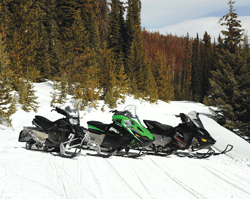When seated on the machines, the Nytro had the best feel for performance riders of the machines in this test. The cockpit is commanding. The seat has the right density, the bars are perfect with an almost seamless transition from grips to hooks and the floorboards are wide and without obstruction. The only gripe against the Nytro is the worthless windshield, which is there for showroom appeal. In the real world, it does little. The handguards offer the protection from debris, but have warm gloves when the mercury dives deep.
Instrumentation on the Nytro is fabulous, but depending on driver height, the view is blocked by the handlebars. If you can spot it when seated, it’s easy to read on the fly. Controls for the warmers are easy to operate, but the clunky reverse handle by the right knee feels Atari vintage. Isn’t push-button reverse the way to go now?
The REV moves drivers more forward than the newer, driver-forward chassis designs from the other manufacturers, which positions the legs differently than the other chassis. Even on the Adrenaline, with its lower handlebars, moving to a stand-up position is easy. Handlebar height is comfortable for seated driving, and an OK height for brief standing, too.
The Ski-Doo’s ergonomics are falling behind. Instrumentation is stuck in the ’90s and Ski-Doo needs to extend handlebar hooks to more then just its “X” customers. Now that other manufacturers have embraced the rider-forward concept without the extreme position of the REV chassis, we’ve seen that the rider-forward benefits can be realized without knees bent and ankles under the rider (see Yamaha, Polaris and Arctic Cat for examples). For some, though, this will remain the preferred position and REVs aren’t going to stop selling tomorrow.
Polaris applied many of the same rider-forward concepts as the REV chassis, but is a bit more middle-of-the-road in terms of rider position. It gets riders to sit up but keeps their feet under their knees rather than behind the knees like a REV. The new IQ machine made huge strides in the ergonomics department with a simple change to a decent set of handlebars.
The new bars are 1 inch wider than the ones they replace, and they are straighter and come with hooks at the bar ends. We’d like to see the same grip material on the hooks, too. As is, the hooks are slippery. Controls are easy to access, but if they were larger they would be easier to operate.
The seat is nice and supportive if not a little on the stiff side. It also has a nice contour near the top for easy maneuvering with changing driver positions. The right footwell has the chaincase intrusion, which is cumbersome, and one tester thought the bars were too tall at the standard setting. A Polaris official made comment that the stock position is indeed tall, but it looks better in the showroom that way. Instrumentation is easy to read at speed and has all the requisite features.
The REV’s gauges, by comparison, are more difficult to read. The white-faced, analog faces are attractive but the numerics are smallish and difficult to read while underway. The needles are large and well illuminated, so owners who memorize the dials will know with a glance where the needles are pegged. Even with that glance, however, drivers sit higher and require taking their eyes off the trail to look down at the gauges.

